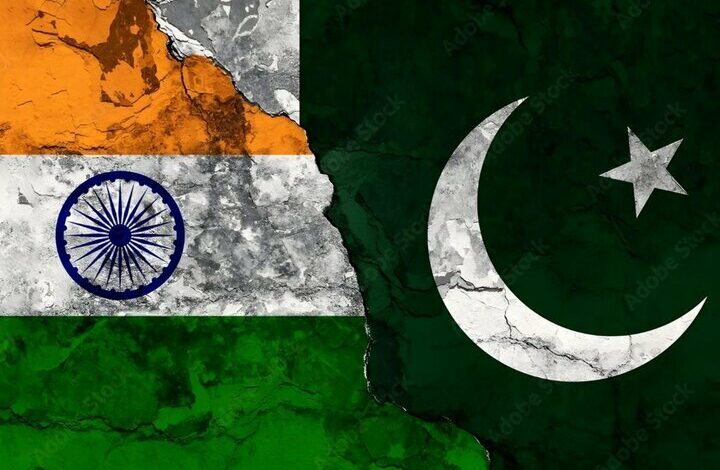The possibility of a full-scale war between India and Pakistan is weak

An Indian political expert, referring to the impact of conflicts in the Eurasian region, emphasized: The likelihood of war between India and Pakistan is low as the New Delhi government currently lacks the capacity for large-scale confrontation.
Mehr News Agency, International Group – Azar Mahdavan: Recent developments in the Indian subcontinent and Pakistan have once again drawn global attention. The two countries, which share a long history of tensions and conflicts, have faced new challenges in recent years that not only affect their bilateral relations but could also impact regional stability—and even beyond.
The issue of Kashmir, historically one of the main points of contention between India and Pakistan, has now evolved into a complex, multifaceted crisis. alongside this matter, new geopolitical developments—including India’s military and economic collaborations with…The United States,along with internal tensions and terrorist attacks,has added to the dimensions of this crisis.
This situation has raised questions about the future of India-Pakistan relations and the role of global powers like China and the U.S. in this equation.
In an interview with Mehr News Agency, Dr. Damla Çağla Bayram, a Turkish expert on Indian political affairs, discussed various aspects of these developments—including why the Kashmir issue remains unresolved, the impact of terrorist attacks on bilateral relations, and potential consequences of any military conflict.The full interview follows:
Why has the Kashmir issue remained unresolved after so many years? Experts suggest that while the current situation may remain a managed crisis, escalating disputes over water and Kashmir have increased the likelihood of a larger conflict. What is your take on this?the unresolved nature of the Kashmir issue stems from both sides claiming ownership of the territory, with neither willing to back down. In essence,the Kashmir conflict resembles a chronic ailment that persists in people’s lives. When each party holds its own set of truths on the matter, reaching a viable solution seems unlikely. Consequently, the current situation is more likely to remain a controlled crisis. For now, small-scale clashes and diplomatic maneuvers are occurring, with tensions unlikely to escalate further.
However, India may launch a targeted counterattack in response to terrorist strikes. This retaliation could take the form of limited airstrikes, similar to those carried out after the Pulwama attack in 2019. Yet, such actions do not appear imminent and are still in the planning stages.
When discussing Kashmir…Water rights are also being used as a geopolitical weapon. While this issue alone does not escalate into a full-scale war, it fuels tensions alongside the kashmir conflict. India currently holds an advantageous position regarding the Indus Waters, while Pakistan faces unfavorable conditions. The Indus River originates in Indian territory and flows toward Pakistan. Over the years, India has constructed numerous dams and implemented water management policies that have altered the river’s flow and direction—changes Pakistan is unlikely to accept. Consequently, the water dispute has gradually intensified, remains unresolved, and continues to exacerbate tensions parallel to the Kashmir issue.
Despite two full-scale wars in 1965 and 1971 and smaller conflicts like Kargil, the Shimla Agreement remains valid. However, many people lack detailed knowledge about this treaty’s provisions. The truth is that no exemption clauses exist within this agreement…The treaty can be amended. However, neither party has the right to unilaterally alter or terminate this agreement. Thus, the Indian government’s decision to suspend the treaty lacks legal basis, as no clause permits either country to take such action. If Pakistan had referred this matter to the International Court of Justice, India’s violation would have been proven.
The Shimla agreement explicitly states that both countries will respect each other’s security and territorial integrity and resolve disputes peacefully. Though, the issue of Indus waters is not limited to India and Pakistan—it also involves China and Afghanistan. Tensions among these nations are currently ongoing. India’s use of Indus waters as a weapon against Pakistan legitimizes China’s ability to control Tibetan waters like the Brahmaputra and Mekong. Restricting water access to another country could be considered a war crime, and India…It can only affect a small portion of the water currently flowing into Pakistan. to achieve such an action, India would need to construct large dams and make significant investments.
If India begins building infrastructure to commit such war crimes, it will portray itself as a negative actor in the region. however, it should be noted that the Kashmir issue does not solely involve India and Pakistan—China is also part of the equation, as certain parts of Kashmir are under Chinese control. China, which advocates for moderation on both sides, is primarily concerned about its partnership with pakistan and the fate of the China-Pakistan Economic Corridor (CPEC) in these territories. A crisis between India and Pakistan would also pose a major threat to this corridor.
On April 21, Trump’s vice president made an official visit to India. Are this visit and the terrorist attack in Kashmir related?
Yes, the U.S. Vice president’s trip to…India and the terrorist attack in Kashmir acted in unison, and this issue could be considered a significant indicator. During this attack, both the U.S. Deputy Secretary of State and India’s Foreign Minister were engaged in international activities. On one hand, India was striving to strengthen its trade and defense cooperation with the United States, while conversely, it sought to enhance trade relations with Saudi Arabia—one of its key allies in the Persian Gulf.
This attack could be seen as an attempt to remind India that there are still destabilizing elements at play—a matter that foreign players should consider as they expand relations with India. The terrorist attack was an informational setback for India. The country was aware of this group’s existence and had made efforts to contain them, but the facts revealed a complex game. What surprised me most was that India failed to anticipate that the presence of a U.S. Deputy Secretary of State on its soil could provide an opportunity for undermining…The Internationalization of the Kashmir issue and the Normalization of Its Situation Could Eliminate Tensions.
Every two countries possess nuclear weapons and are members of the Shanghai Cooperation Organization. Additionally, India is one of the founding members of the BRICS group, and Pakistan is also seeking membership in this bloc. On one hand, it should not be forgotten that China and Pakistan enjoy vrey strong relations. On the other hand, India-china relations are relatively balanced, especially with regard to BRICS, and are currently expanding. Another factor is India’s military power—Russia being another.
With these explanations, could a war between these two countries impact stability in Eurasia and influence Western Asia?
Certainly, a war could affect stability in Eurasia. Though, an significant point is that under current circumstances, India has no desire for war. India is a player with experience in wars against Pakistan and China—and it knows well that at present, it should not engage in conflict with pakistan. Similarly, India understands that it must not rely entirely on America nor allow its strategic autonomy to be compromised by external pressures or dependencies on global powers like Russia or China for defense needs without careful consideration of long-term consequences within shifting geopolitical dynamics where alliances may change unpredictably over time due to emerging multipolar realities reshaping conventional power structures across regions including South Asia where territorial disputes such as Kashmir remain unresolved despite diplomatic efforts aimed at de-escalation through dialog mechanisms involving third-party mediation when necessary but frequently enough hindered by mutual distrust rooted ancient grievances dating back decades if not centuries ago making resolution complex yet imperative peace regional security broader international community stakeholders invested maintaining stability volatile flashpoints potential trigger larger conflicts destabilizing effects beyond immediate vicinity thus necessitating cautious approach all parties involved prioritize dialogue over confrontation while addressing underlying issues fairly sustainably ensuring lasting solutions rather temporary fixes merely postponing certain confrontations future generations inherit unresolved tensions perpetuating cycle violence instability detriment all concerned ultimately undermining shared prosperity cooperation achievable peaceful means alone…China may enter the tension. the situation in the region is somewhat different.
China is currently investing in its partnership with Pakistan and improving relations with Russia.In the event of a war initiated by India, China will not remain silent, and this pressure point is India. For this reason, Delhi has wisely managed its calculations well. The U.S., while openly supporting India, will never fully rely on America and does not want to place itself in a position of dependency on Washington.
Analysts believe that a conflict between Pakistan and India would benefit the U.S., as it would harm China—but I do not accept this view. A war between these two countries would undoubtedly damage Pakistan and China but would also weaken India,which america currently needs as a strong ally. The primary interest of the U.S. here is to maintain regional stability and deter any escalation that could have broader geopolitical consequences.
Let us not forget that China and India are currently…They are repairing their relations, and foreign actors are also not prepared for war under the current circumstances. Although China has declared its support for Pakistan, Europe and even Russia will not respond to such a risk.
Ultimately, India wants to demonstrate that if a war breaks out, it will be Pakistan that initiates it—not India.India will take measures that do not equate to war and whose tensions remain controllable. In reality, this Indian stance signifies controlling the escalation of conflict. Simply put, India seeks to prevent hostilities while simultaneously signaling to foreign powers that now is not the time for war.


